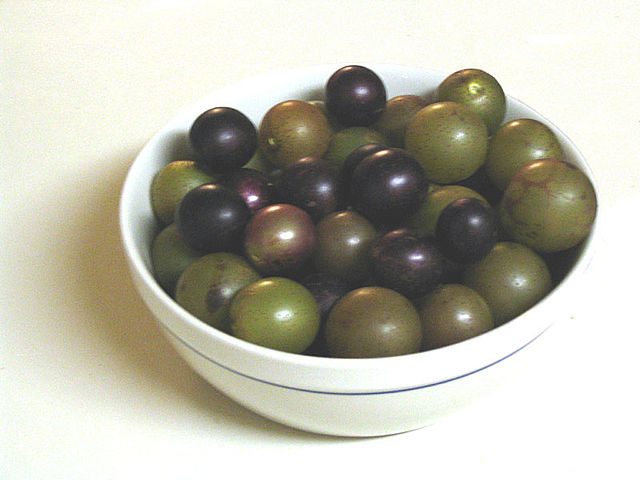Scuppernong: Difference between revisions - Wikipedia
 Article Images
Article Images
Content deleted Content added
m |
m |
||
Line 1: [[Image:Muscadines.Scuppernongs.jpg|right|300|thumb|Some muscadines in a bowl; the green ones are scuppernongs]] The '''scuppernong''' {{IPAc-en|ˈ|s|k|ʌ|p|ər|ˌ|n|ɒ|ŋ}} is a large variety of [[muscadine]] (''Vitis rotundifolia''),<ref>{{cite web|url=http:// ==History== The name comes from the [[Scuppernong River (North Carolina)|Scuppernong River]] in [[North Carolina]] mainly along the coastal plain. It was first mentioned as a "white grape" in a written logbook by the [[Florence|Florentine]] explorer [[Giovanni de Verrazzano]] while exploring the [[Cape Fear River]] Valley in 1524.<ref>{{cite web|url=http://www.scuppernongs.com/id2.html |title=North Carolina Wine & Grape Council and NCDOC |publisher=Scuppernongs.com |date= |accessdate=2012-08-09}}</ref> He wrote "...Many vines growing naturally there...". [[Sir Walter Raleigh]]'s explorers, the captains [[Phillip Amadas]] and [[Arthur Barlowe]], wrote in 1584 that North Carolina's coast was "...so full of grapes as the very beating and surge of the sea overflowed them...in all the world, the like abundance is not to be found." He may have been referring to [[Sargassum|Sargasso seaweed]] from coral reefs, which can be seen washed up on shore after a major storm off of the NC coast. The seaweed has berrylike gas filled bladders looking much like grapes to keep the fronds afloat. However in 1585, Governor Ralph Lane, when describing North Carolina to Raleigh, stated that "We have discovered the main to be the goodliest soil under the cope of heaven, so abounding with sweet trees that bring rich and pleasant, grapes of such greatness, yet wild, as France, Spain, nor Italy hath no greater...". It was first cultivated during the 17th century, particularly in [[Tyrrell County|Tyrell County, North Carolina]]. Isaac Alexander found it while hunting along the banks of a stream feeding into Scuppernong Lake in 1755; it is mentioned in the North Carolina official state toast.<ref>{{cite web|url=http://www.ncleg.net/enactedlegislation/statutes/html/bysection/chapter_149/gs_149-2.html |title=GS_149-2 "A Toast" to North Carolina 2005 |publisher=Ncleg.net |date= |accessdate=2012-08-09}}</ref> The name itself traces back to the [[Algonquian languages|Algonquian]] word ''ascopo'' meaning "sweet bay tree". ==Cultivation== | |||